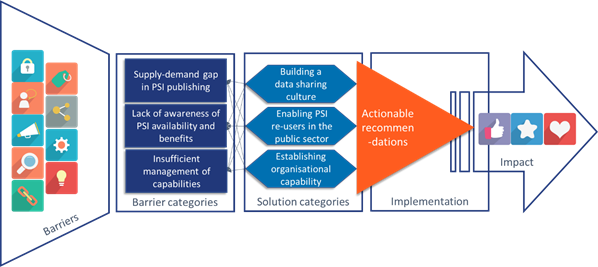EDP publishes report: PSI re-use in the public sector
The public sector on the journey from making data available to re-using it. Abstract of EDP's analytical report no 11 on re-use of PSI in the public sector
The European Data Portal (EDP) initiative does research on current topics related to open data and publishes the findings, for example, in form of analytical reports. The analytical report no 11 focuses on the challenges of PSI re-use in the public sector and gives recommendations on how to support and realise successful PSI re-use in the public sector. We thank the research participants, who substantially enriched, challenged and shaped our research and the findings by participating in the interviews and the workshop on PSI re-use in the public sector.
Abstract of the analytical report no 11: PSI re-use in the public sector
The public sector generates and stores valuable information in form of data. When made open, the data is available to anyone for re-use, including public organisations themselves. Re-using the data helps to develop insight, services or products. Thereby public organisations can improve the efficiency of internal processes, service delivery and data-driven decision making, which supports better policies and therefore positively affects society.
The Directive on Public Sector Information (PSI) defines which government-held data should be re-usable and under what conditions. It entails requirements on who must publish PSI and how to select and publish it. Since the introduction and implementation of the PSI Directive, more Public Sector Information has been published by government institutions. Over the years, research such as the European Data Portal's "Open Data Maturity Report" has shown that governments across Europe started acknowledging the need to open up more data to make it available for re-use.
Although there are more and more datasets open, public organisations are not yet exploiting the benefits of their re-use. The report identifies barriers, discusses solutions and concludes with eight actionable recommendations for successful PSI re-use in the public sector.

Figure 6 Supporting PSI re-use in the public sector
Three categories of barriers
Based on interviews and a remote workshop with our research participants, we identified three categories of barriers to PSI re-use in the public sector.
- Supply-demand gap in PSI publishing: Sufficient supply of PSI is a prerequisite for its re-use. Despite the PSI Directive, the main barrier to data re-use is still the availability of PSI. This is not limited to the quantity of data, but also the selection, the quality and the consistency of publication.
- Lack of awareness of PSI availability and benefits: A lack of general awareness of PSI and its benefits is a main reason why the potential impact of PSI is not yet leveraged in the public sector.
- Insufficient management of capabilities: Against common belief, it is not a lack of special competence that hinders PSI re-use. In fact, re-using PSI is not fundamentally different from re-using other data. It is rather the exaggerated competence expectations that can act as a barrier to PSI re-use. Development towards successful PSI re-use is often insular and misses support due to insufficient organisational competence, lack of leadership and lack of confidence in the data and re-use possibilities.
A common root cause of barriers to PSI re-use is a lack of knowledge exchange and insufficient management of processes and capabilities.
Solutions to overcome the barriers
In our research, we reviewed and discussed solutions for successful PSI re-use and formulated three main approaches to overcome the barriers in the public sector.
- Building a data sharing culture: Enabling and encouraging communication can close the gap between how PSI providers supply data and what the re-users demand from them. Knowledge exchange and dialogue can be facilitated by, e.g. implementing PSI feedback options for re-users, building relationships to PSI providers or initiating PSI re-use communities.
- Enabling PSI re-users in the public sector: To raise initial awareness, the applicability of PSI to address actual needs has to be communicated and illustrated. To enable re-users and initiatives in the public sector, digital competences have to be developed and incentivised as part of an organisation's capability.
- Establishing the organisational capability for PSI re-use: To exploit the benefits of PSI re-use, an organisation's leadership has to set an ecosystem that incubates and supports the development of competencies. That includes acquiring talent with a suitable competency-set for defined roles and responsibilities, implementing digital tools and the administrative and technical infrastructure favouring PSI re-use. Projects including PSI re-use have to be planned and managed, and results monitored and analysed to achieve process excellence.
Recommendations
A set of eight steps on how to become a successful PSI re-user in the public sector concludes the report. The first three steps are:
- Take advantage of learning resources such as the European Data Portal's eLearning and complete modules on open data and PSI. You are now qualified to be a PSI expert and ambassador.
- Share your insights and thoughts within your team and organisation, learn from mistakes and scale up.
- Make open data an integral part of the business cases of your future projects. Showcase the benefit of PSI re-use to justify any necessary investment.
Read the analytical report no 11 to explore all eight recommended steps and to gain further insight into the assessment and evaluation of the barriers and solution for successful PSI re-use in the public sector.
You can also browse our previous reports:
- Report 1: Digital Transformation and Open Data
- Report 2: E-Skills and Open Data
- Report 3: Open Data and Privacy
- Report 4: Open Data and Cities
- Report 5: Barriers in working with Open Data
- Report 6: Open Data and Cities 2
- Report 7: Open Data in the European Union Neighbourhood
- Report 8: The Future of Open Data Portals
- Report 9: Economic benefits of Open Data
- Report 10: Open Data and Entrepreneurship
